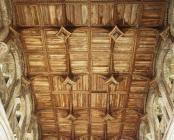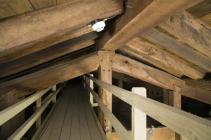St David’s Cathedral
Items in this story:
City and Cathedral
The westernmost peninsula of Pembrokeshire is dominated by the city and cathedral close of St Davids, spiritual home of the patron saint of Wales, which has stood as a place of religious sanctity and pilgrimage for well over a millennium.
In medieval times it was said that two pilgrimages to St Davids were equal to one to Rome. The site of St David's original early Christian community, thought to have lain west of the city, has long been lost to history and archaeology and has passed into the realms of legend. This early community was short-lived, however, and was soon moved inland to the banks of the River Alun where the cathedral stands today. By the ninth century St Davids or Menevia was a famous Welsh monastery and a cult centre for followers of the famous saint. While the earliest sections of the cathedral date back only to the twelfth century, it is thought likely that the layout of the medieval cathedral close wall may have followed the line of the pre-existing religious enclosure.
The great nave ceiling
The great nave ceiling at St David’s cathedral is one of the greatest timber works of art in Wales. The ceiling is dominated by huge pendants which float impressively above the name but are without any religious symbolism whatsoever.
The roof has been the object of much admiration since the late sixteenth century but it is not known exactly when it was built or indeed who built it. Various myths have collected around the roof: it is said to have been made of Irish bog oak and by Flemish (or ‘foreign’) craftsmen. The roof has a strongly marked Renaissance character, especially in the detailing of the pendants. It has twelve bays (with obvious symbolism) and pendants at the intersections of the moulded beams. The pendants are in the form of little castles with carvings of renaissance type of masks and paired dolphins.
The tree-ring dates
The hidden part of the roof is as remarkable as the visible part. One can only reach the roof-trusses by climbing a tight stone stair within the west end of the nave and walking across the ‘leads’ of the aisle roof to another stair turret that leads finally to the hidden roof. The nave ceiling is suspended from a roof of king-post type with a large central post that supports the ridge-beam.
The tree-ring dates tell an unexpectedly complicated story. Three phases have been identified: a stock-piling phase in the early sixteenth century; construction in the second quarter of the sixteenth century; and a phase of repair and consolidation in the mid-sixteeth century. This complex sequence is consistent with the documentary sources: these indicate that the roof was commissioned before 1509 and was partly constructed by the 1530s, but that work stopped between 1536 and 1548.
So we know when the roof was built – not long before the Reformation. The tree-ring sequences established that the roof was constructed from Welsh oak and not (as legend has it) Irish oak. What about the foreign craftsmen? There may be some truth in this. King-posts roofs are common enough in the eighteenth century but an absolute rarity in England and Wales until used by Christopher Wren and other seventeenth-century architects influenced by Italian architecture. The king-posts roof does suggest that the nave roof at St David’s was influenced directly or indirectly by continental/Italian models. Indeed it has a good claim to be the earliest roof of this type in the British Isles.


